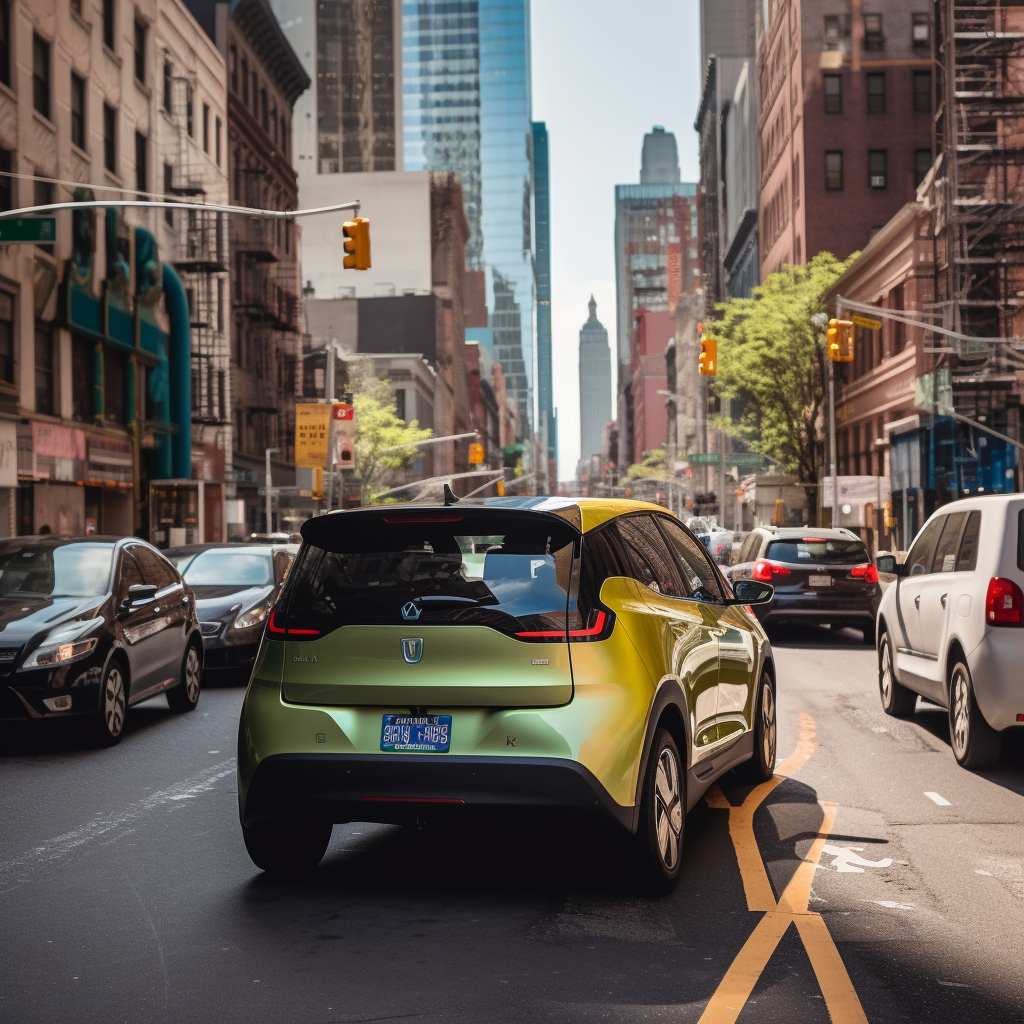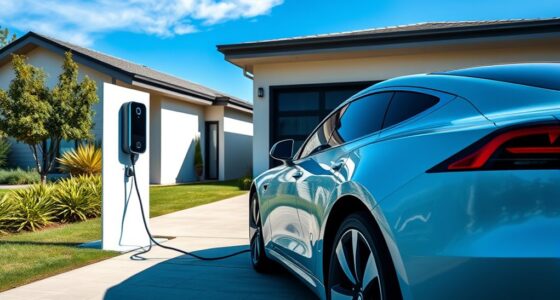The future of e-bikes and e-vehicles is all about seamless integration through smart technology, shared ecosystems, and innovative infrastructure. Expect advanced battery systems, rapid charging stations, and lightweight materials to boost performance and sustainability. Connectivity via IoT enables real-time data, safety features, and smart charging, while urban planning emphasizes infrastructure that supports multi-modal travel. This convergence is shaping eco-friendly urban mobility—stick with us to explore these exciting developments further.
Key Takeaways
- Increased integration of e-bikes and e-vehicles within multi-modal platforms for seamless urban mobility.
- Adoption of advanced battery tech, like solid-state batteries, enabling longer ranges and faster charging across both modes.
- Development of smart infrastructure, including rapid-charging stations and IoT-enabled docking, supporting quick mode switching.
- Enhanced connectivity features and autonomous capabilities driving greater safety, efficiency, and user customization.
- Regulatory frameworks and incentives fostering widespread adoption and standardization of converging e-bike and e-vehicle ecosystems.
The Rise of Shared and Interoperable Mobility Ecosystems

The rise of shared and interoperable mobility ecosystems is transforming urban transportation by making it more seamless and accessible. Shared mobility options like e-bikes are expanding rapidly, with over 200 million rides annually, promoting inclusive urban travel. Interoperability connects these e-bikes with public transit and electric vehicles, enabling smooth multi-modal journeys. Major tech companies develop unified platforms so you can rent, access, and pay for different transport modes with a single app, enhancing connectivity. Data from shared systems helps manage traffic in real time and improves urban planning, reducing congestion. IoT and 5G technology enable interoperability between e-bikes, e-scooters, and EVs, ensuring coordinated charging, maintenance, and a better user experience across mobility modes. Incorporating comfort solutions such as ergonomic design and user-friendly interfaces can further enhance user satisfaction and adoption of these integrated systems. Additionally, focusing on organization and decluttering of these platforms can facilitate a more streamlined and user-centric experience, encouraging wider adoption and sustainability. Proper cost and budgeting strategies can also ensure that these mobility solutions remain affordable and sustainable for users and providers alike. Moreover, integrating home furnishings like ergonomic seating and convenient storage options into e-bike designs can improve overall user comfort and usability during transit and stops. As technology advances, the integration of skin-friendly materials into e-bike components may also improve user comfort and reduce potential skin irritation during prolonged use.
Advances in Battery Technologies and Energy Management
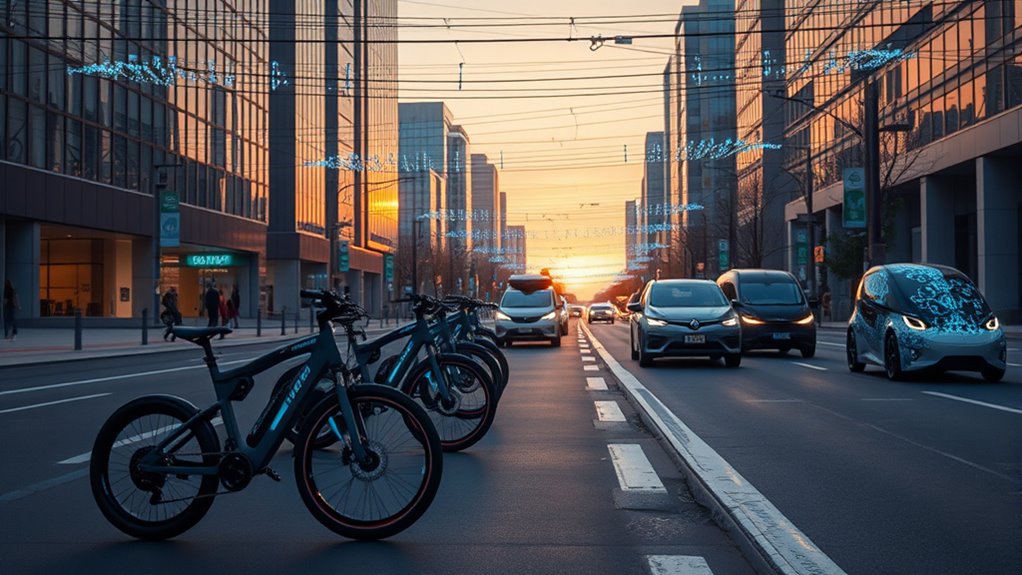
Advances in battery tech, like solid-state batteries, are boosting safety, energy density, and lifespan for e‑bikes and e‑vehicles. Fast-charging innovations are shrinking recharge times, making electric mobility more practical and versatile. Meanwhile, smarter energy management systems are optimizing battery use and extending their durability, supporting sustainable growth. Additionally, ongoing research into precious metals investment is enhancing the development of more efficient and durable components in energy storage solutions.
Solid-State Battery Benefits
Solid-state batteries are revolutionizing energy storage by replacing liquid electrolytes with solid materials, which substantially boosts safety by eliminating leaks and fire risks. These batteries provide higher energy density, allowing e-bikes and e-vehicles to achieve longer ranges without increasing size or weight. Their design supports faster charging times, potentially reducing charges from hours to minutes as technology advances. Solid-state batteries also enhance safety by minimizing thermal runaway risks, making your vehicle safer in daily use. Additionally, their improved lifespan and stability mean fewer replacements, lowering long-term costs and reducing environmental impact. Although manufacturing challenges remain, ongoing research aims to make solid-state batteries commercially viable and widely adopted, promising a future where energy storage is safer, more efficient, and environmentally friendly.
Fast-Charging Innovations Developments
As battery technology progresses, rapid charging becomes more feasible, allowing e-bikes and e-vehicles to recharge in minutes rather than hours. Advances in battery technology, such as solid-state batteries with solid electrolytes, enable faster recharge times without sacrificing safety. These batteries offer higher energy density, supporting longer ranges while maintaining quick charge capabilities. Emerging innovations from collaborations like Nanotech Energy and Voltaplex focus on fireproof, high-capacity cells that support rapid recharge without safety risks. Enhanced battery management systems optimize energy flow, allowing ultra-fast chargers exceeding 350 kW to recharge batteries efficiently while preserving longevity. AI-driven energy management solutions further guarantee safety and battery health during fast charging, making rapid-charge e-mobility solutions more practical and widely accessible. High-capacity batteries are essential for supporting the growing demand for quick and efficient charging solutions in the e-mobility sector. Additionally, ongoing research into renewable energy integration aims to make the entire charging process more sustainable and environmentally friendly.
Sustainable Energy Management
Innovations in battery materials and energy management systems are transforming sustainable mobility by enhancing performance and safety. Solid-state batteries, with their solid electrolytes, provide higher energy density, faster charging, and improved safety compared to traditional lithium-ion options. Energy management systems now allow real-time monitoring and optimization, extending battery life and reducing energy waste. Smart technology enables seamless integration with e‑bikes and e‑vehicles, supporting sustainable energy use and grid interaction. Additionally, eco-friendly, fireproof materials from collaborations like Nanotech Energy and Voltaplex improve safety and sustainability. Recycling processes recover valuable materials such as lithium, cobalt, and nickel, minimizing environmental impact and fostering a circular economy. Proper tire storage practices and regular inspections further contribute to the longevity of e-mobility components. Ongoing research into advanced battery recycling techniques promises to further reduce waste and environmental footprint, driven by innovations in recycling processes and sustainable material development. The development of sustainable energy management strategies is crucial for maximizing efficiency and reducing environmental impact in future e-mobility solutions. These advancements create a more efficient, safer, and environmentally conscious future for e-mobility.
Integration of Connectivity: IoT and Smart Features
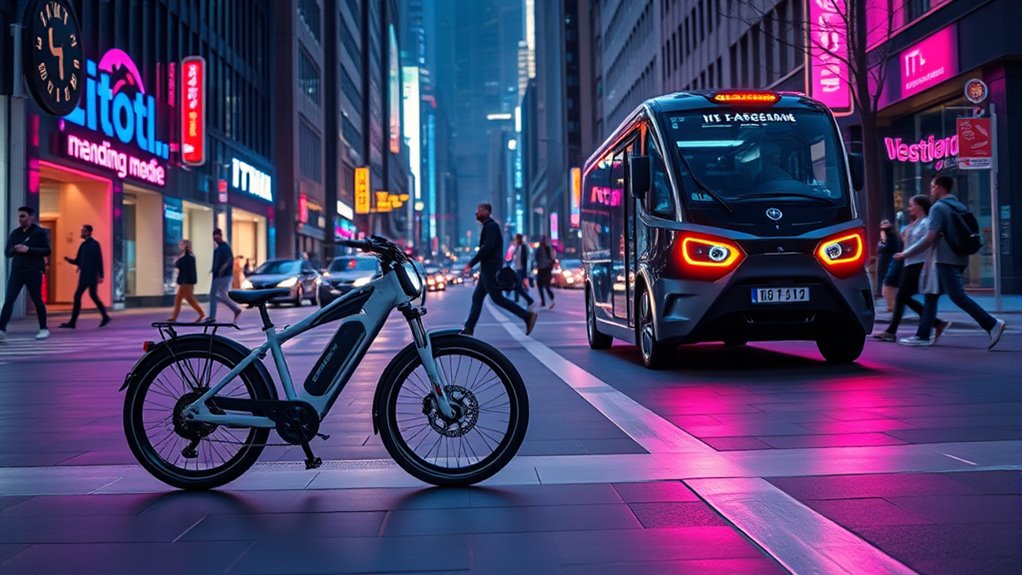
The integration of IoT and smart features into e-bikes transforms how you interact with your vehicle, offering real-time monitoring and enhanced security. Connectivity enables you to track battery health, ride data, and security alerts directly through smartphone apps. Smart features like GPS navigation, anti-theft systems, and automatic diagnostics are now embedded, making your riding experience safer and more efficient. You can also perform firmware updates remotely, customizing ride modes and optimizing performance on the fly. IoT connectivity allows your e-bike to communicate with smart infrastructure, such as charging stations and traffic systems, improving safety and efficiency. The data collected supports predictive maintenance, enabling proactive repairs and reducing unexpected breakdowns. This integration not only enhances user convenience but also contributes to sustainable transportation by optimizing energy use and encouraging eco-friendly commuting. Moreover, the adoption of standardized communication protocols ensures compatibility across different devices and systems, promoting a seamless user experience. Additionally, compliance with privacy policies ensures that user data is protected while maximizing the benefits of connectivity.
Lightweight Materials and Structural Innovations
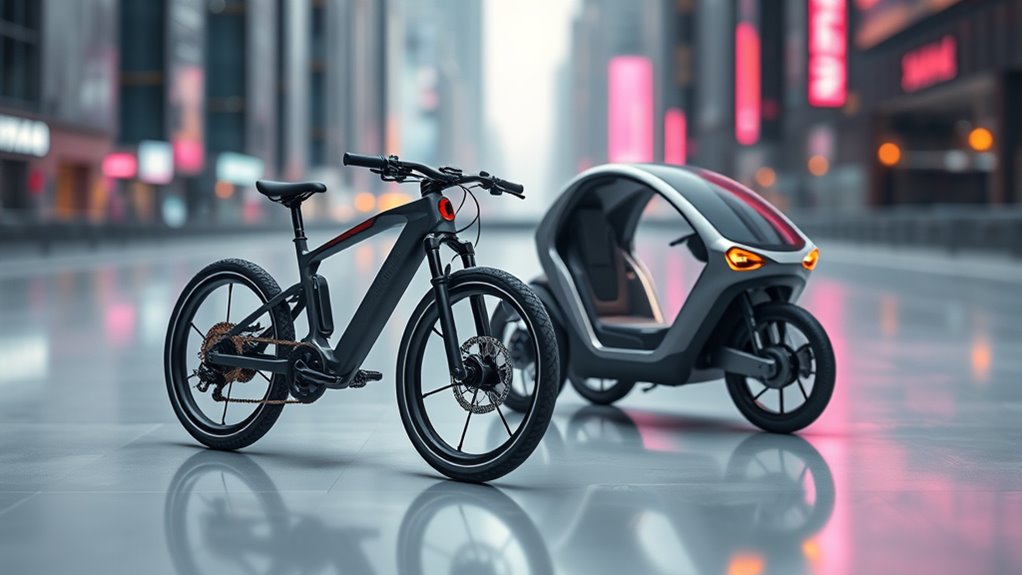
Building on the enhanced connectivity and smart features now common in e-bikes, advancements in lightweight materials and structural designs are making rides more agile and convenient. Using carbon fiber composites and aluminum alloys, bike frames weigh under 20kg, boosting portability and handling. Structural innovations, like hinge mechanisms and foldable designs, simplify storage and transport, especially for commuters and cargo models. Lightweight polymers and advanced composites increase durability while reducing weight, supporting longer ranges and better maneuverability. Additionally, the integration of specialized materials enhances the overall safety and resilience of the vehicles in various environments, and understanding state tax implications can be vital for consumers considering different models and usage plans. The development of manufacturing techniques is also contributing to more efficient production processes and cost reductions. Moreover, incorporating eco-friendly materials from sustainable sources aligns with the growing emphasis on environmentally conscious transportation solutions.
Rapid Charging and Infrastructure Development

Rapid charging and infrastructure development are transforming how e-vehicles and e-bikes meet user needs for convenience and efficiency. Ultra-fast charging stations exceeding 350 kW are popping up in cities, cutting down charging times markedly. Governments support this shift through policies like FAME I and II, promoting intelligent, fast-charging infrastructure. Battery swapping ecosystems are gaining popularity, offering quick exchanges for long-range travel and time savings. Advances in smart charging enable integration with renewable energy sources, making charging more sustainable. IoT-enabled charging networks help optimize grid management and reduce waiting periods.
- Quick access through fast charging stations
- Expanding charging infrastructure across cities
- Incorporating renewable energy for greener solutions
- Battery swapping for rapid exchanges
- Smart charging for efficiency and grid support
Multi-Modal Transportation Solutions for Urban and Rural Areas

You can improve mobility by combining e-bikes and e-vehicles within integrated transit networks that connect urban centers and rural communities. Innovative solutions like battery swapping stations and smart docking make switching between modes quick and easy, even in areas with limited infrastructure. Policy support and dedicated infrastructure, such as bike lanes and charging stations, help create seamless, sustainable multi-modal travel options for everyone.
Integrated Transit Networks
Integrated transit networks are transforming how we move through cities and rural areas by seamlessly combining e-bikes, e-scooters, and e-vehicles with public transportation. You can now enjoy multi-modal mobility options that make commutes faster and more convenient. Cities like Paris and Amsterdam are leading the way with bike-sharing schemes linked to e-scooter and e-car services, improving first- and last-mile connectivity. These systems help reduce urban congestion and emissions while making travel more flexible. Investments in infrastructure, such as dedicated lanes, charging stations, and docking hubs, support these integrated solutions. Smart mobility platforms with real-time routing and payment systems further streamline your experience, making it easier to switch between modes and optimize your journey.
- Seamless connections between modes
- Reduced travel times by up to 30%
- Infrastructure supporting e-bike integration
- Smart payment and routing systems
- Lower urban congestion and emissions
Rural Connectivity Enhancements
Building on the advances in urban mobility, efforts to enhance rural connectivity now focus on integrating e-bikes with existing public transit systems to create seamless multi-modal options. By deploying charging stations and leveraging improved battery technology, you can support longer rides and reliable e-bike use in rural areas. Lightweight, foldable e-bikes with extended battery life—over 50 miles per charge—make it easier to travel between urban centers and remote regions. Smart infrastructure like battery swapping stations and fast chargers ensure dependable access, even where grid access is limited. Combining e-bikes with autonomous shuttles and microtransit services enhances rural connectivity, promoting sustainable mobility. Data shows rural e-bike adoption increased by 35% where these multi-modal solutions are in place, emphasizing their role in expanding accessibility.
Collaborations and Competitive Dynamics in Tech Convergence
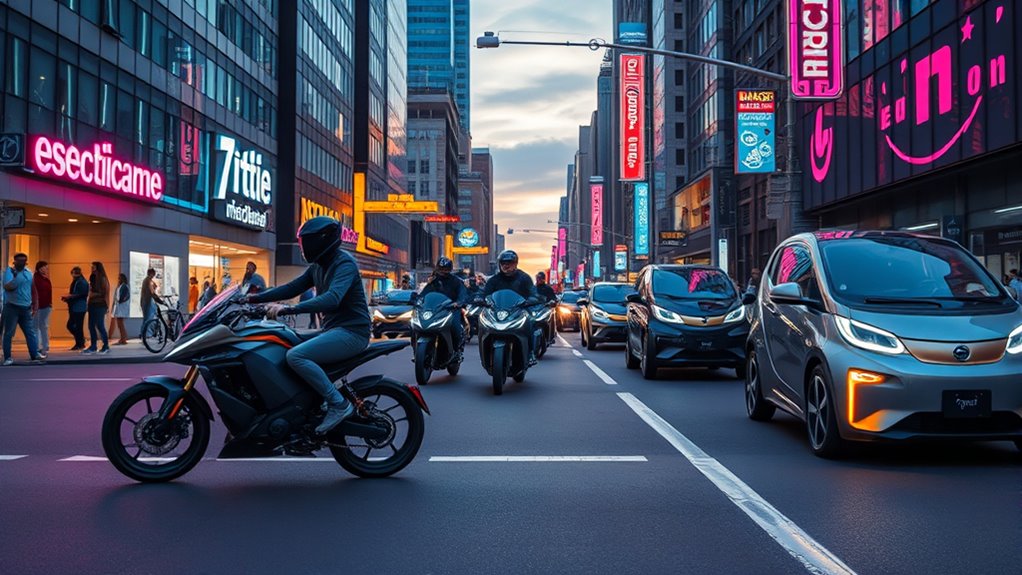
Strategic collaborations between traditional automakers and e-bike manufacturers are rapidly transforming the mobility landscape, fostering the integration of e-bike and e-vehicle technologies. These partnerships accelerate innovation, especially in battery technology, with companies like Samsung SDI and CATL leading the charge in solid-state and high-capacity batteries that benefit both sectors. Industry alliances are also developing shared features such as smart connectivity, GPS navigation, and safety systems, making e-bikes and e-vehicles more alike. The formation of interoperable charging ecosystems and battery swapping networks further blurs industry lines, creating seamless user experiences. As collaborations grow, the market for connected mobility solutions is projected to reach over $50 billion by 2030, fueling rapid growth and competition in this evolving space.
- Industry alliances foster interoperability across platforms
- Innovations in battery tech drive sector advancements
- Shared features enhance user experience and safety
- Collaborations accelerate the adoption of integrated solutions
- Competition pushes rapid technological progress
Regulatory Frameworks Supporting Seamless Transition
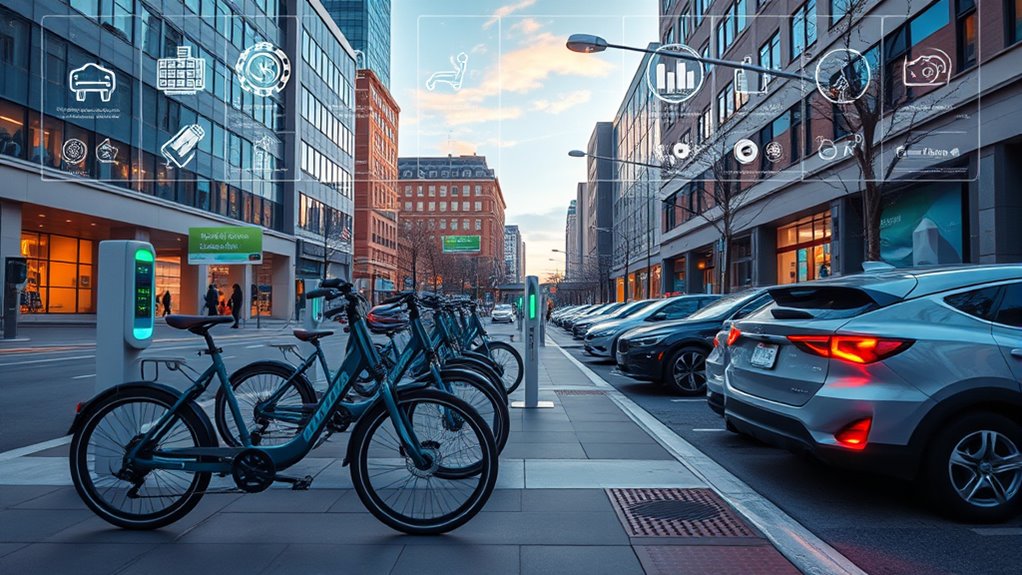
Regulatory frameworks are essential in facilitating a smooth shift between e-bikes and e-vehicles, ensuring that policies support interoperability and user safety. Across Europe, legislation like class classifications and age restrictions influence design and safety standards, promoting safer, compatible systems. Standardization efforts, supported by policies such as the EU’s Green Deal and national incentives, enable cross-border recognition and certification of e-bikes and e-vehicles. These policies also include incentives like regional rebates and programs such as California’s E-Bike Incentive Project, encouraging adoption and aligning with emission reduction goals. International initiatives aim to harmonize charging standards, licensing, and insurance policies, creating a unified regulatory environment. These frameworks foster innovation, safety, and seamless integration, paving the way for a more connected and sustainable mobility future.
Impact on Urban Planning and Sustainable Development
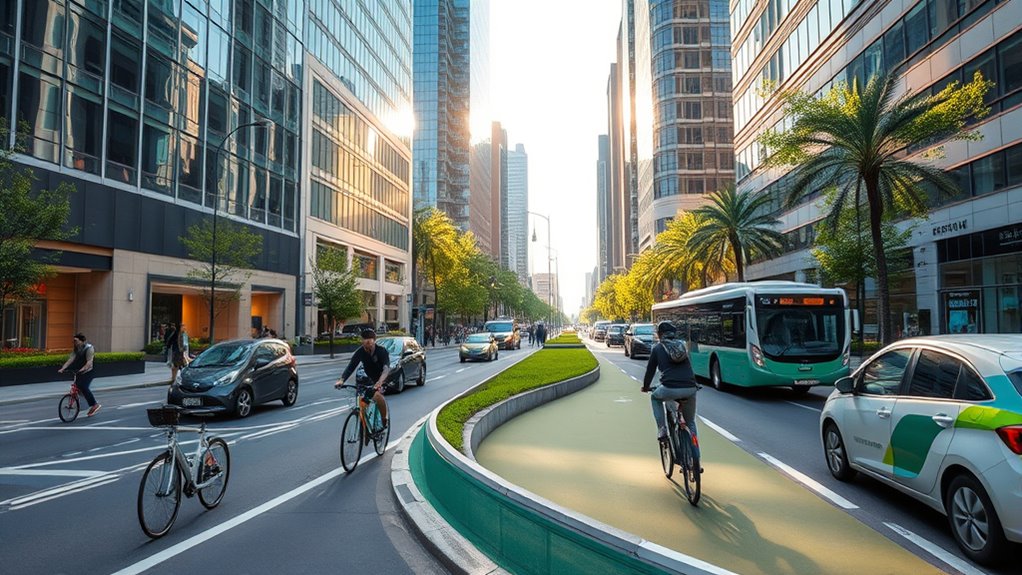
The integration of e-bikes and e-vehicles is transforming urban planning by promoting sustainable development and smarter mobility solutions. You’ll notice cities investing in dedicated cycling infrastructure, like cycle paths and smart signage, to support safer, more accessible e-mobility. This shift encourages multi-modal transportation, allowing seamless progression between e-bikes, public transit, and e-vehicles, which reduces congestion and emissions. Advancements in charging infrastructure, including rapid-charging stations and better battery tech, enable longer trips and quicker recharges, making eco-friendly options more practical. Policies favoring local manufacturing and connectivity foster resilient, low-carbon urban landscapes that prioritize micro-mobility. As a result, you’ll see cities becoming more sustainable, efficient, and better equipped for future mobility needs.
Future Market Trends and Consumer Adoption Patterns

As technological innovations and growing consumer interest drive the e-bike market, it is projected to expand at a compound annual growth rate of 7.7% from 2023 to 2028. You’ll see consumer adoption increase as interest shifts toward lightweight, connected e-bikes equipped with smart safety features, like the popular Specialized Turbo Vado SL 4.0. Government incentives, such as California’s E-Bike Incentive Project, further boost adoption across different socioeconomic groups. The convergence of e-bike and e-vehicle technologies—featuring advanced batteries, autonomous functions, and connectivity—accelerates acceptance of multi-modal electric mobility solutions. Market trends now favor versatile e-vehicles, including cargo bikes and e-mountain bikes, expanding e-mobility beyond urban commuting and shaping future consumer preferences toward sustainable mobility.
Frequently Asked Questions
How Will Data Privacy Be Maintained With Increased Iot Integration?
You might worry about data privacy as IoT devices become more common, but you can stay protected by using strong encryption and secure networks. Regularly update your devices and apps to patch vulnerabilities. Be cautious about what data you share and read privacy policies carefully. By taking these steps, you help ensure your personal information stays safe, even as connected devices grow more integrated into your daily life.
What Are the Cost Implications for Consumers Adopting Combined E-Bike and EV Systems?
You might think adopting combined e-bike and EV systems costs a fortune, but the truth is, it could save you thousands in the long run. Initial investments might seem steep, yet with shared infrastructure and maintenance, expenses drop dramatically. Plus, you’ll enjoy reduced fuel and parking costs, making your commute cheaper and greener. Over time, the combined system becomes a smart, economical choice, transforming your transportation wallet and lifestyle.
How Will Standardization Efforts Impact Compatibility Across Brands and Models?
Standardization efforts will considerably enhance compatibility across brands and models, making it easier for you to switch or upgrade components without worries. When manufacturers adopt common standards, you benefit from increased interoperability, reduced costs, and simplified maintenance. This means you can confidently choose from a wider range of e-bike and e-vehicle options, knowing they’ll work seamlessly together. Ultimately, standardization empowers you with more flexibility and savings in your mobility choices.
What Safety Measures Are Being Developed for Interconnected Mobility Networks?
Think of interconnected mobility networks like a well-orchestrated symphony. You’ll find safety measures such as advanced sensors, real-time data sharing, and automated alerts being developed to keep you safe. Developers are focusing on cybersecurity, fail-safe systems, and improved communication protocols to prevent accidents. These innovations aim to create a seamless, secure experience, ensuring your rides are safer as networks become more interconnected and intelligent.
How Will Government Policies Adapt to Support Integrated E-Mobility Solutions?
You’ll see government policies evolve to support integrated e-mobility by creating clear regulations for e-bike and e-vehicle use, ensuring safety standards, and investing in infrastructure. They’ll promote seamless connectivity across transport modes, encourage sustainable practices, and offer incentives for adopting eco-friendly transportation. These policies aim to make shared mobility safer, more accessible, and efficient, ultimately fostering a more sustainable and integrated transportation system that benefits everyone.
Conclusion
As you embrace the future of mobility, you’ll see e-bikes and e-vehicles seamlessly merging, transforming cities into futuristic metropolises faster than you can say “hoverboard.” With smarter batteries, connected features, and innovative materials, this convergence makes sustainable commuting easier and more efficient. Keep an eye on evolving regulations and infrastructure, because this revolution will accelerate, turning your daily ride into a smooth, high-tech adventure—no flux capacitor needed.










